Plenty of jobs and low unemployment in the UK, but skills shortage remains…
The latest employment figures from the Office for National Statistics (ONS) for the period March to May 2018 shows there were 32.4 million people in the UK in employment, up some 137K from the previous quarter and nearly 400K more than for the equivalent period in 2017.
The overall employment rate in the UK now stands at 75.7%, which is the highest level since the current records began in 1971.
The unemployment rate stands at 4.2% – the lowest since 1975.
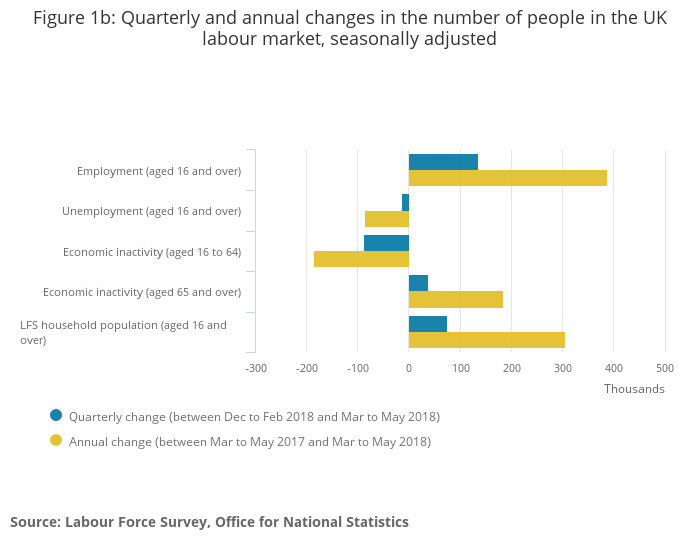
In spite of the media’s obsession with Brexit and the potential negative economic consequences of virtually any kind of EU divorce settlement, the labour market figures appear to show that UK businesses are getting on with doing business and creating jobs in the economy.
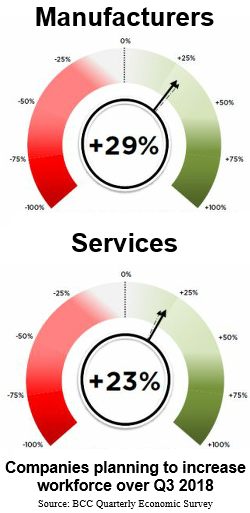 The British Chamber of Commerce Quarterly Economic Survey for Q2 2018 indicates that 29% of manufacturers and 23% of service firms expect to grow their workforce over next three months.
The British Chamber of Commerce Quarterly Economic Survey for Q2 2018 indicates that 29% of manufacturers and 23% of service firms expect to grow their workforce over next three months.
Although based on a survey and measuring sentiment, the British Chambers of Commerce Economic Survey is based on responses from over 6000 member firms across the country and can be a useful tool to measure the confidence of UK businesses.
In the latest release, 47% of Manufacturers and 40% of Services companies thought that turnover would increase over the next 12 months.
This level of confidence is mirrored in other respected sources like the Bank of England’s Agents’ summary of business conditions for Q2 2018.
It notes growth in domestic manufacturing, an uptick in retail sales, solid growth in Business Services and “modest excess demand” for Commercial Real Estate.
Interestingly, it also highlighted concerns over recruitment:
Recruitment difficulties remained elevated and widespread across sectors and job roles.
While many companies are keen to hire, the constraining factor is finding and securing the people with the right skills.
CV Library’s 2018 Q2 report may not have the same authority as the ONS, the BCC or the Bank of England, but it’s nevertheless useful to note trends identified by one of the UK’s larger job boards.
CV Library reports that the number of vacancies posted on their site was up 11.6% compared to Q2 2017, which suggests that there is still plenty of hiring activity. There was an above average increase in jobs posted for a number of cities:
- Hull – jobs up by 38%
- Liverpool – jobs up by 19.7%
- Sheffield – jobs up by 18.9%
- Leeds – jobs up by 15.2%
- London – jobs up by 14.2%
- Glasgow – jobs up by 13.5%
- Edinburgh – jobs up by 12.1%
- Newcastle – jobs up by 11.6%
- Manchester – jobs up by 10.7%
- Birmingham – jobs up by 10.6%
The sectors with the largest year on year rise in advertised vacancies were agriculture (38.2%), legal (26.6%), IT (19.9%), hospitality (18.7%) and manufacturing (17%).
However, although there was an increase in the number of jobs advertised, CV Library reports that application rates across the UK fell in the second quarter of 2018 when compared to the same period last year.
With such high rates of employment it is hardly surprising that there are fewer candidates for the advertised jobs.
The Skills Shortage
There are well recognised skill shortages in several sectors including construction, healthcare, education and some IT disciplines, where employers are in a constant battle to attract the best talent.
While there has been much written over the years about skills shortages in various sectors, it can be difficult to gauge the scale and extent of the shortfall.
Handily, the Home Office produces a ‘shortage occupation list’ which identifies those jobs where there is a genuine shortage. The purpose of this list to make it a bit easier to get non-EU migrant workers to take up positions in UK companies, so if you make the ‘shortage occupation list’ there probably is a pretty small pool of suitably skilled and qualified people to pick from.
The whole topic of the UK skills gap and skills shortages is perhaps one for another day, but the current shortage occupation list includes all sorts of engineering disciplines, IT specialisms like data scientists, developers and cyber security specialists, many medical occupations including all types of nursing, and secondary teachers in maths, physics, computer science and Mandarin.
Prospects – the graduate career site – highlights current shortages in the following areas:
- Arts – artists, dancers, graphic designers and musicians
- Education – secondary school teachers (particularly maths teachers)
- Engineering – electrical, mechanical and chemical engineers, civil engineers and product and process engineers
- Healthcare – nurses, medical radiographers, paediatricians
- Hospitality – chefs
- IT – software developers and systems engineers
- Science – biological scientist and biochemists, physicists and geologists
- Social care – social workers
Perhaps no great surprises here, but it is clear that potential employees with the right experience and skillset know they have choices in todays job market and of course they will shop around when considering their career options.
Standing out from the crowd
With historic low levels of unemployment and many skilled and qualified employees happy in their current jobs, organisations really need to stand out from the crowd to attract the attention of what might be a very small pool of candidates.
A few years ago, it used to take a bit of effort to research a company you were thinking about applying to work for. Larger companies might have had some press coverage and maybe you could request a company brochure intended for investors. Smaller companies would be much more difficult to research, and unless you knew someone who already worked there it would be virtually impossible to find out much about what went on behind closed doors.
In the days of the internet and social media, however, potential candidates have a wealth of information about nearly all organisations available at the click of a button or a tap on a screen.
Increasingly a company’s online presence is the first port of call for both active and passive job seekers when looking at potential employers.
What impression does your online footprint give?
With a company web site, social media like Twitter, Facebook, Instagram and LinkedIn, and review sites like Glassdoor and Indeed just a couple of clicks away, your first impression to potential new recruits is likely to be online.
Just as recruitment agencies and in house recruiting teams will qualify and grade applications, so will potential candidates rate (and often reject) potential employers based on what they see online – irrespective of how good your job adverts are or how good a company you are to work for.
Your website may not have to be the latest cutting edge design (unless you are in a creative sector), but it does need to be quick to load, look good on a mobile device and give a good impression of your organisation. Sites that are difficult to navigate, have broken links or dated content aren’t likely to encourage quality people to see you as an employer of choice.
If your Facebook page has comments from dissatisfied customers or unanswered questions, it isn’t doing anything for your reputation.
Does your Twitter feed suggest a professional organisation with expertise in its field or just a stream of ‘here’s something I found on the internet’ shares and retweets? Are you followed by leaders in your sector? Is your Twitter account adding value to your brand or detracting from it? Should you even have a Twitter account? Lots of very successful organisations manage very well without it.
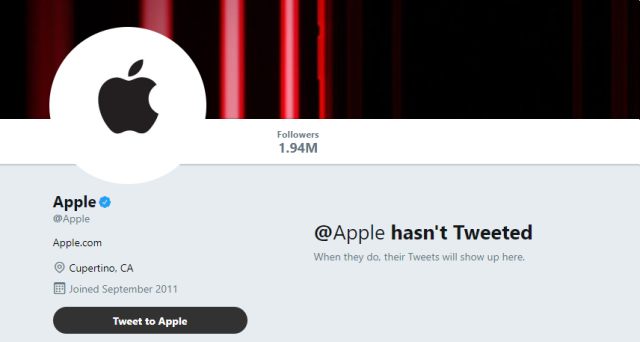
If you are posting your Instagram photos of company nights out and teambuilding events to show how much fun everyone has, are you missing out on that superstar developer who just wants the tools and the time to do a great job and who would be horrified at the thought of being forced into social situations with work colleagues?
If your career pages show a pool table and table football and breakout areas for gaming and a beer cart on Fridays and you can bring your dog to work and take as much time off as you like – are you attracting the kind of people your business really needs to thrive and grow?
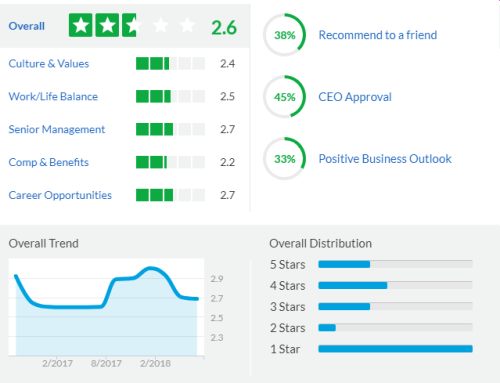 No matter what you say on your website (‘our people are our most important asset’), if all your Glassdoor reviews say you micromanage employees, everything is KPI driven and you have a terrible retention rate, you will struggle to attract quality people.
No matter what you say on your website (‘our people are our most important asset’), if all your Glassdoor reviews say you micromanage employees, everything is KPI driven and you have a terrible retention rate, you will struggle to attract quality people.
While company review sites like Glassdoor can be an outlet for disgruntled former employees to vent their spleen, most people can recognise outlier reviews – good and bad. For organisations of any size, the chances are your Glassdoor or Indeed company ranking is what you deserve.
When did you last Google your company to see what shows up? Does your own company website even show on page one? What about competitors?
Your online presence is your organisation’s shop window. It’s viewed by potential customers, suppliers and employees. It should attract attention and make them stop and have a look inside. But there is no point in having a flash exterior if the business inside doesn’t live up to expectations.
If you want potential employees to consider working for you, you’d better have a decent online presence. It doesn’t have to be flashy or clever. But it should have a consistent and honest message. And it helps if it’s better than your competition!
Need Help?
Many companies’ online footprint has evolved in a pretty haphazard way over time.
First you get a website, then there is the company LinkedIn page, then everyone said you had to be on Facebook, so you set up a page there. Then there was Twitter, then Pinterest then Instagram. You have a G+ account as well, but you only set that up so you could create your Google My Business listing to show up on Google Maps. You claimed your employer account on GlassDoor, but you haven’t got around to doing much with it yet.
Then there was the website refresh/rebrand and you added the ‘work for us’ section, but there wasn’t really enough time to get it right and now most of the people shown there have already left.
And there’s a YouTube channel that was set up when everyone said you had to be using video. There’s a couple of videos up there with a few dozen views – can anyone remember how much they cost?
It’s easy to end up with a mish-mash of inconsistent branding, mixed messages and out of date content.
And it’s difficult for people inside your organisation to take an objective view of your online presence.
If you need a fresh pair of eyes to give you an expert, objective review of your companies online footprint – and prioritised, practical steps to make your company brand more appealing to potential customers, suppliers and future employees – fill in the form to the right to find out more about our online review services.
A periodic review of your web site, social media channels and other online assets is the best way to ensure you are presenting your organisation at its best and taking full advantage of the great opportunities available online to drive sales and attract talent!
Can we help?
Does your online presence attract applications from quality candidates? When a potential employee checks out your online reputation, does it live up to the quality of your business?
If you want some practical advice on steps you can take to improve your online footprint and help attract new clients and employees, fill in the form below to arrange a no-obligation call to see if we can help.

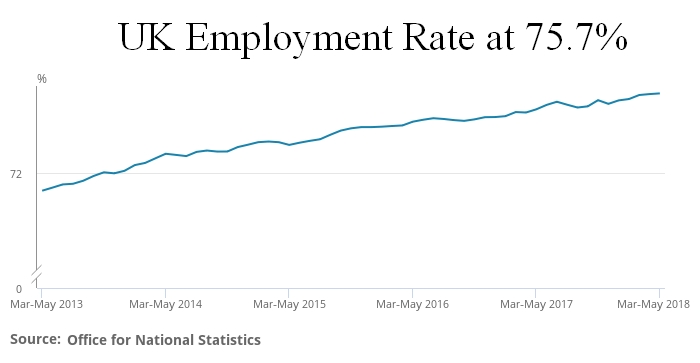
Recent Comments